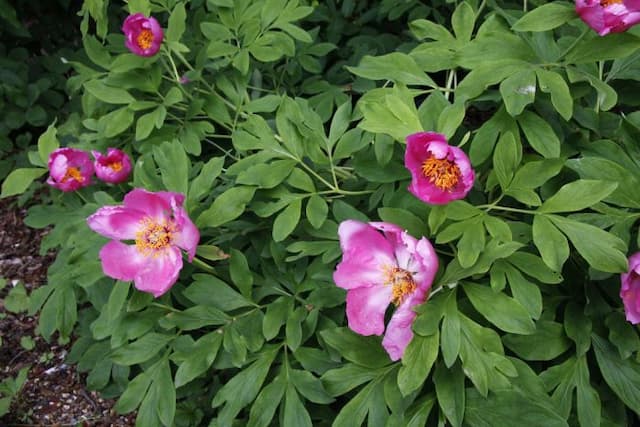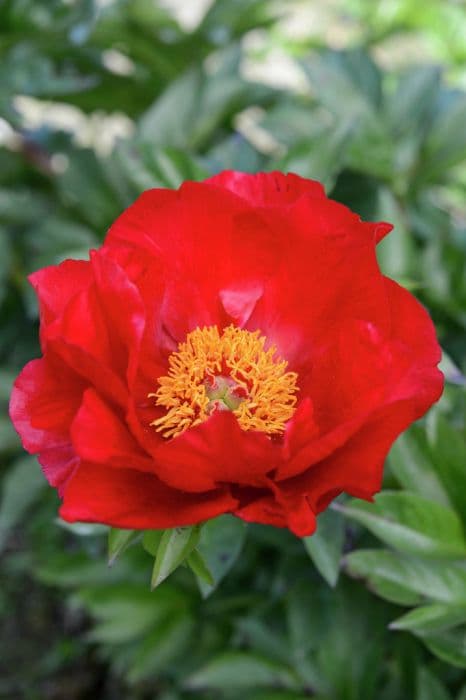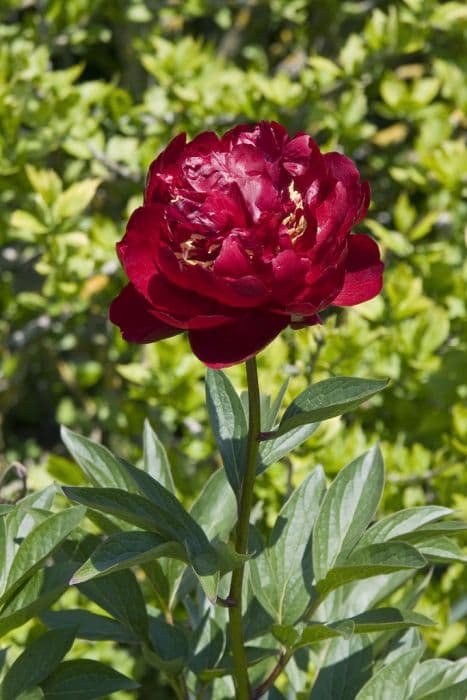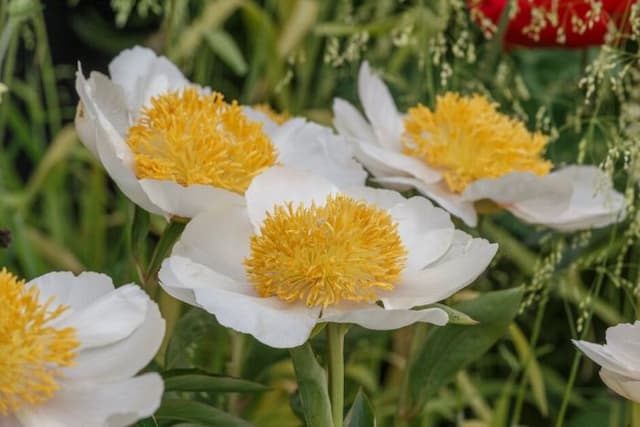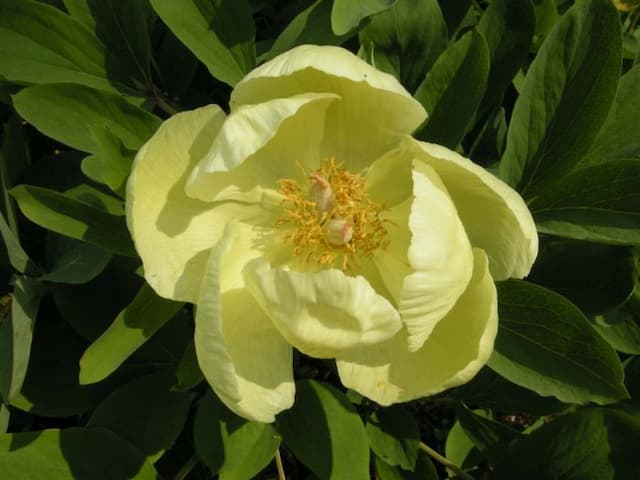Chinese Peony Paeonia lactiflora 'Lan Ju'

ABOUT
'Lan Ju' is a variety of peony that boasts stunning flowers and attractive foliage. The blossoms of this plant are particularly noteworthy, with their large, showy blooms that exhibit multiple layers of delicate petals. These petals have a soft, almost silky texture, and their color can be described as a dreamy shade of bluish-pink, with subtle variations that give a dynamic and rich visual texture to each flower. The center of the bloom is a contrast of textures and colors, often sporting a cluster of contrasting golden-yellow stamens that create a striking focal point against the cool tones of the petals. The outer petals may often be darker and as the eyes move inward, the petals can become lighter, creating an enchanting gradient effect. As for the foliage, 'Lan Ju' peony has luscious deep green leaves that offer a bold backdrop to the softness of the flowers. The leaves are compound with each leaf consisting of several leaflets that are symmetrically arranged along the stem. The shape of the leaflets is typically ovate with a gentle point at the apex and the edges are subtly serrated. Overall, the 'Lan Ju' peony exudes a classic elegance with its delightful blossoms that are reminiscent of pastel watercolors and its lush greenery that compliments the soft display of its flowers. This plant is beloved for the romantic ambiance it brings to any garden display.
About this plant
 Names
NamesFamily
Paeoniaceae.
Synonyms
Chinese Peony, White Peony, Common Garden Peony.
Common names
Paeonia lactiflora 'Lan Ju'.
 Toxicity
ToxicityTo humans
The common name for Paeonia lactiflora 'Lan Ju' is Peony. Peonies are not generally considered toxic to humans. If ingested in large quantities, however, they could potentially cause gastrointestinal upset, such as diarrhea or nausea. Touching the plant may cause skin irritation in some sensitive individuals. Always practice caution and avoid ingesting parts of ornamental plants, as individual reactions can vary.
To pets
The common name for Paeonia lactiflora 'Lan Ju' is Peony. Peonies are considered to be mildly toxic to pets, such as cats and dogs. If a pet ingests parts of a peony plant, they may experience symptoms such as vomiting, diarrhea, or drooling. Contact with the plant can sometimes also cause skin irritation. If you suspect your pet has ingested peony, it is recommended to consult with a veterinarian.
 Characteristics
CharacteristicsLife cycle
Perennials
Foliage type
Deciduous
Color of leaves
Green
Flower color
White
Height
2 feet 4 inches (70 cm)
Spread
2 feet 4 inches (70 cm)
Plant type
Herb
Hardiness zones
3
Native area
Asia
Benefits
 General Benefits
General Benefits- Ornamental value: Paeonia lactiflora 'Lan Ju', commonly known as the Chinese Peony, produces large, fragrant flowers that enhance the beauty of gardens and landscapes.
- Longevity: Chinese Peonies are known for their ability to live for many years, and even decades, in the right growing conditions.
- Pollinator attraction: The blossoms of the Chinese Peony attract pollinators such as bees, which are essential for the health of ecosystems.
- Seasonal interest: With their lush, full blooms appearing in late spring to early summer, Chinese Peonies provide seasonal interest and color to gardens.
- Cut flower use: The blooms of the Chinese Peony are popular for arrangements and bouquets, lasting well when cut and placed in water.
- Drought tolerance: Once established, Chinese Peonies are relatively drought tolerant, making them suitable for gardens in climates with occasional dry spells.
- Easy maintenance: Chinese Peonies require minimal care once planted, needing only occasional watering and fertilizing for optimal growth.
- Cold hardiness: These plants are well-adapted to survive cold winters, making them suitable for gardens in cooler climates.
 Medical Properties
Medical Properties- Anti-inflammatory: May help reduce inflammation in various tissues.
- Analgesic: Has been used traditionally to alleviate pain.
- Immunomodulatory: Potential to modulate the immune system.
- Antioxidant: Contains compounds that may help in protecting the body from oxidative stress.
- Anxiolytic: May have mild sedative effects that help in reducing anxiety.
 Air-purifying Qualities
Air-purifying QualitiesThis plant is not specifically known for air purifying qualities.
 Other Uses
Other Uses- Cut flowers: Paeonia lactiflora 'Lan Ju', commonly known as peony, is often used in floral arrangements due to its large, showy blooms that can add elegance and a delightful fragrance to bouquets.
- Symbolism in art: Peonies are a popular motif in paintings and textiles, symbolizing wealth, honor, and high social status in various cultures, particularly in East Asia.
- Wedding decorations: Peonies are used extensively in wedding decor, from centerpieces to bridal bouquets, owing to their lush petals and romantic associations.
- Garden aesthetics: As ornamental plants, peonies can serve as a beautiful focal point in landscape design, providing a splash of color when in bloom.
- Photography subject: The peony's striking appearance makes it a favorite subject for photographers, especially in macro photography to showcase its intricate details.
- Crafts and DIY: The petals of peonies can be used in crafting, such as making paper or silk flowers for various decorative purposes.
- Culinary decoration: Although not commonly used for culinary purposes, peony petals can be used as an elegant garnish to beautify dishes and desserts.
- Perfumery: Peony scents are sometimes captured in perfumes for their fresh, floral fragrance, contributing to delicate and feminine compositions.
- Cultural festivals: In some traditions, peonies play a role in cultural festivities, where they're showcased in gardens and public spaces to celebrate their blooming season.
- Dye production: The vibrant colors of peony petals can potentially be used to produce natural dyes for fabrics, although this is not a common use.
Interesting Facts
 Feng Shui
Feng ShuiThe Peony is not used in Feng Shui practice.
 Zodiac Sign Compitability
Zodiac Sign CompitabilityThe Peony is not used in astrology practice.
 Plant Symbolism
Plant Symbolism- Beauty: The Paeonia lactiflora, commonly known as the Chinese peony, is often associated with beauty owing to its large, full blooms and vibrant colors.
- Romance: The plant symbolizes romance and is frequently used in weddings and romantic bouquets to represent love and affection.
- Prosperity and Good Fortune: In Chinese culture, the peony is a symbol of wealth and honor, often representing a wish for continued success and prosperity.
- Femininity and Charm: The delicate and lush appearance of the peony has made it a symbol of femininity and the allure of female charm.
- Compassion: Some cultures associate peonies with compassion and nurturing, perhaps echoing the gentle appearance of the flower's petals.
- Happy Marriage: The Chinese peony is also considered a good omen for a happy marriage, making it a popular gift for newlyweds and anniversaries.
 Water
WaterPeonies like the Paeonia lactiflora 'Lan Ju' should be watered deeply approximately once a week during their growing season if there has been no substantial rainfall, using about 1 inch of water which might add up to about 0.6 gallons for a standard 12-inch pot. Overhead watering should be avoided to prevent fungal diseases; instead, water at the base of the plant. In the fall, reduce watering as the plant prepares for dormancy. If the plant is in well-draining soil and it's receiving adequate rain, additional watering might not be necessary.
 Light
LightPeonies such as the Paeonia lactiflora 'Lan Ju' thrive in full sun to partial shade. They require a minimum of six hours of direct sunlight to bloom successfully, but they can tolerate light afternoon shade in hot climates. The best spot is an area that receives morning sun and some afternoon protection, especially in regions with intense late-day sun.
 Temperature
TemperaturePeonies like Paeonia lactiflora 'Lan Ju' prefer a temperate climate with winter chill to initiate blooms. They can survive winter temperatures down to about -20°F and are hardy in USDA zones 3 to 8. Ideal growing temperatures during the growing season range from 65°F to 75°F, but they can tolerate summer highs up to 85°F.
 Pruning
PruningPeonies like Paeonia lactiflora 'Lan Ju' should be pruned to remove spent blooms after flowering and cut back to the ground in the fall after frost to prevent overwintering diseases. They benefit from selective removal of excess foliage during the summer to improve air circulation. The best time for major pruning is in the fall after the leaves have died back.
 Cleaning
CleaningAs needed
 Soil
SoilPeony 'Lan Ju' thrives in well-draining, fertile soil enriched with compost or well-rotted manure. A blend of two parts garden soil, one part compost or manure, and one part perlite or sand is ideal. Maintain a slightly acidic to neutral pH of 6.5-7.0 for optimal growth.
 Repotting
RepottingPeonies like 'Lan Ju' rarely need repotting as they prefer to be left undisturbed. They can remain in the same location for years, but if necessary, repotting is best done in the fall every 10-15 years or when the plant outgrows its space.
 Humidity & Misting
Humidity & MistingPeony 'Lan Ju' is tolerant of a wide range of humidity conditions and does not have specific humidity requirements. As long as the plant is planted in the ground and has proper soil and watering, humidity should not be an issue.
 Suitable locations
Suitable locationsIndoor
Peonies like 'Lan Ju' are not ideal for indoor growing due to size and light needs.
Outdoor
Plant in a sunny spot with well-drained soil and shelter from strong winds.
Hardiness zone
3-8 USDA
 Life cycle
Life cycleThe common name for Paeonia lactiflora 'Lan Ju' is the Chinese Peony 'Lan Ju'. The life cycle begins with seed germination, occurring in late winter or early spring, which is followed by the development of a small shoot that emerges from the soil. Gradually, foliage develops into a bushy form with large, dark green leaves. As the plant matures, it enters the flowering stage in late spring to early summer, where it produces large, fragrant flowers that can be pink, white, or red, often with a double flower form. After pollination, seeds are set in pods that ripen by late summer and can be harvested for propagation or allowed to fall and self-sow. Finally, the plant becomes dormant in the fall, with the foliage dying back with the onset of cold weather, only to regenerate from the perennial rootstock the following spring.
 Propogation
PropogationPropogation time
Spring
The most popular method for propagating the Chinese peony 'Lan Ju', or Paeonia lactiflora 'Lan Ju', is by division of the root system. This is best done in the fall after the plants have gone dormant. To propagate by division, carefully dig up the peony plant, taking care not to damage the roots. Shake off the excess soil and use a sharp knife or spade to cut the root ball into sections, ensuring each section has at least three to five eyes, or growth buds. These sections can then be replanted in well-drained soil at a depth where the eyes are 1 to 2 inches (2.5 to 5 cm) below the soil surface. Water the newly planted divisions thoroughly to help establish them. It's important to allow the divisions to settle for a couple of weeks before the ground freezes to ensure that they root well and are ready for the spring growing season.
